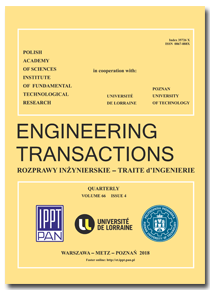10.24423/ENGTRANS.196.2008
Material design of anisotropic elastic cellular bodies with respect to contact problem
References
ANSYS 10.0 manual.
M. Janus–Michalska, Micromechanical model of auxetic cellular materials, submitted for publication in Archives of Metallurgy and Materials.
M. Janus–Michalska, Effective models describing elastic behaviour of cellular materials, Archives of Metallurgy and Materials, 50, 3, 595–608, 2005.
N. Kikuchi, J. T. Oden, Contact problems in elasticity: a study of variational ineqalitiees and finite element methods, SIAM, Philadelphia 1988.
P. Kordzikowski, M. Janus–Michalska, R. B. Pęcherski, Specification of energy – based criterion of elastic limit states for cellular materials, Archives of Metallurgy and Materials, 50, 3, 621–634, 2005.
R. S. Lakes, Foam structures with a negative Poisson’s ratio, Science, 235, 1038–1040, 1987.
R. S. Lakes, Design considerations for materials with negative Poisson’s ratios, Trans. ASME J. Mech., 115, 696–700, 1993.
D. W. Overaker, A. M. Cuitino, N. A. Langrana, Elastoplastic micromechanical modeling of two-dimensional irregular convex and nonconvex (re-entrant) hexagonal foams, Transactions of ASME, 65, 1998.
A. Scalia, Contact Problem for porous elastic half-plane, J. Elasticity, 60, 91–102, 2000.
G. E. Stavroulakis, Auxetic behavior: appearance and engineering applications, Physica Status Solidi, 3, 710–720, 2005.
G. Szefer, D. Kędzior, Contact of elastic bodies with negative poisson’s ratio, Springer V., 2002.
Y. Wang, R. Lakes, Analytical parametric analysis of the contact problem of human buttocks and negative Poisson’s ratio foam cushions, Int. J. Sol. Struc., 39, 4825–38, 2002.
J. Rychlewski, Unconventional approach to linear elasticity, Arch. Mech., 47, 149–171, 1995.
DOI: 10.24423/ENGTRANS.196.2008




